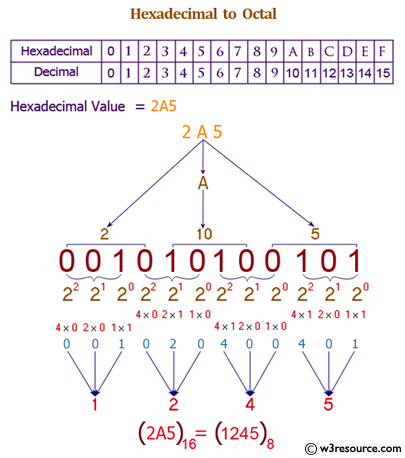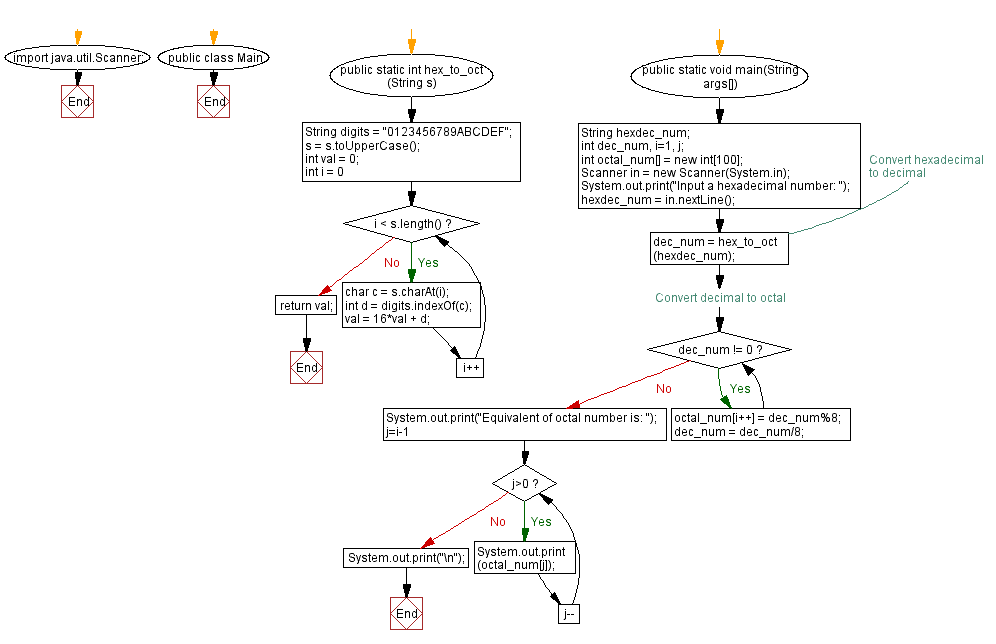Java: Convert a hexadecimal to a octal number
Hexadecimal to Octal Converter
Write a Java program to convert a hexadecimal value into an octal number.
Hexadecimal number: This is a positional numeral system with a radix, or base, of 16. Hexadecimal uses sixteen distinct symbols, most often the symbols 0-9 to represent values zero to nine, and A, B, C, D, E, F (or alternatively a, b, c, d, e, f) to represent values ten to fifteen.
Octal number: The octal numeral system is the base-8 number system, and uses the digits 0 to 7.
Test Data:
Input any hexadecimal number: 40
Pictorial Presentation: Hexadecimal to Octal number

Sample Solution:
Java Code:
import java.util.Scanner;
public class Main {
// Function to convert a hexadecimal string to a decimal integer
public static int hex_to_oct(String s) {
// Define a string containing hexadecimal digits
String digits = "0123456789ABCDEF";
s = s.toUpperCase(); // Convert the input string to uppercase
int val = 0; // Initialize the decimal value to 0
// Iterate through each character in the input string
for (int i = 0; i < s.length(); i++) {
char c = s.charAt(i); // Get the current character
int d = digits.indexOf(c); // Find the index of the character in the digits string
val = 16 * val + d; // Update the decimal value using hexadecimal conversion
}
return val; // Return the decimal value
}
public static void main(String args[]) {
String hexdec_num;
int dec_num, i = 1, j;
int octal_num[] = new int[100];
Scanner in = new Scanner(System.in);
// Prompt the user to input a hexadecimal number
System.out.print("Input a hexadecimal number: ");
hexdec_num = in.nextLine();
// Call the hex_to_oct function to convert the hexadecimal number to decimal
dec_num = hex_to_oct(hexdec_num);
// Convert the decimal number to octal
while (dec_num != 0) {
octal_num[i++] = dec_num % 8;
dec_num = dec_num / 8;
}
// Display the equivalent octal number
System.out.print("Equivalent of octal number is: ");
for (j = i - 1; j > 0; j--) {
System.out.print(octal_num[j]);
}
System.out.print("\n");
}
}
Explanation:
In the exercise above -
- First, it defines a method "hex_to_oct()" that takes a hexadecimal string 's' as input and converts it to its decimal equivalent. It initializes a string 'digits' containing the hexadecimal digits (0-9 and A-F), ensures that the input string 's' is in uppercase, and iterates through the characters to compute the decimal value.
- In the "main()" function, it takes a hexadecimal number as input from the user using the "Scanner" class and stores it in the 'hexdec_num' string.
- It calls the " hex_to_oct ()" method, passing 'hexdec_num' as an argument, to convert the hexadecimal string to its decimal equivalent and stores it in the 'dec_num' variable.
- Then, it converts the decimal number to octal:
- It initializes an integer array 'octal_num' to store the octal digits.
- It enters a loop to perform the decimal-to-octal conversion:
- In each iteration, it calculates the remainder when 'dec_num' is divided by 8 (which gives the least significant octal digit).
- It stores this remainder in the 'octal_num' array.
- It updates 'dec_num' by dividing it by 8 to move to the next octal digit.
- It uses 'i' to keep track of each octal digit's position.
- Finally, it prints the octal representation of the original hexadecimal number by iterating through the 'octal_num' array in reverse order (from the most significant digit to the least significant digit).
Sample Output:
Input a hexadecimal number: 40 Equivalent of octal number is: 100
Flowchart:

For more Practice: Solve these Related Problems:
- Convert a hexadecimal number longer than four digits to octal.
- Modify the program to allow the user to input multiple hexadecimal numbers for conversion.
- Write a program that performs hexadecimal-to-octal conversion without using decimal as an intermediate step.
- Implement hexadecimal-to-octal conversion using lookup tables.
Go to:
PREV : Hexadecimal to Binary Converter.
NEXT :
Check Java Installation.
Java Code Editor:
What is the difficulty level of this exercise?
Test your Programming skills with w3resource's quiz.
